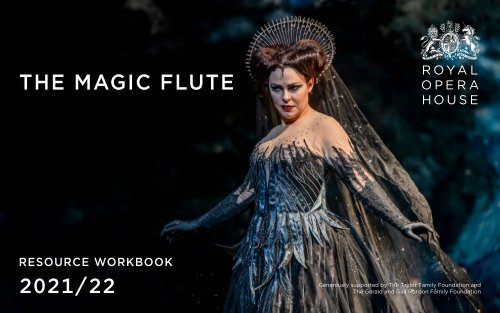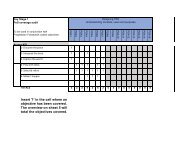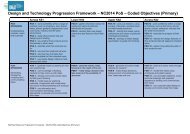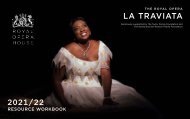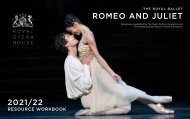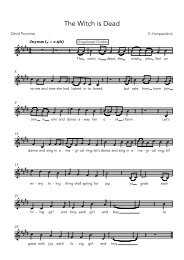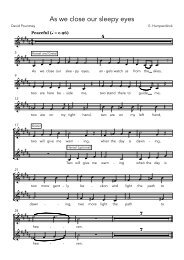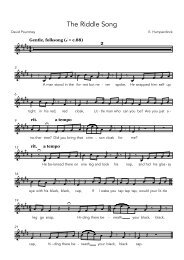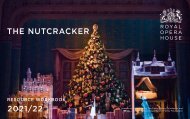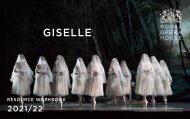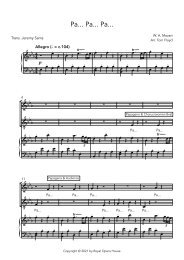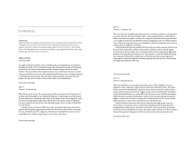The Magic Flute digital resource book
- No tags were found...
Create successful ePaper yourself
Turn your PDF publications into a flip-book with our unique Google optimized e-Paper software.
THE MAGIC FLUTE<br />
RESOURCE WORKBOOK<br />
2021/22<br />
- Generously supported by <strong>The</strong> Taylor Family Foundation and<br />
<strong>The</strong> Gerald and Gail Ronson Family Foundation
YOUR VISIT<br />
We are really excited to welcome you and<br />
your students to the Royal Opera House for<br />
the Schools’ Matinee of <strong>The</strong> <strong>Magic</strong> <strong>Flute</strong> on<br />
Friday 24 September 2021.<br />
Welcome to the Royal Opera House film<br />
This film introduces you and your students to the Royal<br />
Opera House, guiding them through the spaces they will visit,<br />
introducing them to some of the people they will encounter and<br />
some of the exciting things they might see.<br />
Cover and left photo of Tuuli Takala as Queen of the Night in <strong>The</strong> <strong>Magic</strong> <strong>Flute</strong> ©2019 ROH.<br />
Photograph by Tristram Kenton
THE STORY<br />
ACT I<br />
Tamino is saved from a serpent by the Queen of the Night’s<br />
Three Ladies. Papageno pretends he killed the serpent and<br />
the Three Ladies tell him off for lying. <strong>The</strong>y show Tamino<br />
a picture of the Queen’s daughter Pamina and he falls in<br />
love with her. <strong>The</strong>y explain that she is held prisoner by the<br />
evil enchanter Sarastro. <strong>The</strong> Queen tells Tamino that he<br />
can marry Pamina if he rescues her. <strong>The</strong> Three Ladies give<br />
Tamino a magic flute and Papageno some magic bells.<br />
Papageno arrives at Sarastro’s palace and finds Sarastro’s<br />
servant Monostatos threatening Pamina. He helps her<br />
escape and explains that Tamino will rescue her.<br />
Tamino meets a wise old man who tells him that all is not<br />
as it seems. Tamino plays his magic flute. Animals come<br />
and dance, and at last Papageno answers with his pipes.<br />
Pamina and Papageno are discovered by Monostatos and<br />
his men. Papageno plays a cheerful tune on his magic bells<br />
which enchants them, and they dance cheerfully away.<br />
Pamina tells Sarastro and his followers about Monostatos’s<br />
cruel behaviour, and Sarastro orders him to be punished.<br />
Pamina and Tamino are overjoyed to meet at last. However,<br />
Sarastro tells them that Tamino and Papageno must<br />
undergo tests of wisdom. If they succeed, they can join<br />
Sarastro’s Brotherhood.<br />
ACT II<br />
Sarastro and his Priests pray for Tamino and Papageno to<br />
succeed in their tests. Sarastro is confident that Tamino can<br />
become a wise man and live happily with Pamina.<br />
Tamino and Papageno’s first test is to keep silent, even<br />
when they are spoken to. Tamino is determined to keep<br />
his promise, but Papageno is easily distracted, particularly<br />
when the Queen’s Three Ladies arrive and warn them about<br />
Sarastro.<br />
Monostatos tries to kiss Pamina while she is asleep. He<br />
hurries away as the Queen of the Night arrives. <strong>The</strong> Queen<br />
gives Pamina a dagger and tells her to kill Sarastro. Pamina<br />
is very upset and doesn’t know what to do.<br />
Papageno has a strange encounter with an old woman who<br />
tells him that her name is Papagena. Meanwhile Pamina<br />
encounters Tamino, who – keeping his vow of silence –<br />
won’t speak to her. Pamina is in despair.<br />
• Will Pamina carry out her mother’s wicked plan?<br />
• Will Sarastro take revenge on the Queen if Pamina<br />
reveals her plot?<br />
• Will Pamina discover why Tamino seems cold and silent?<br />
• Will Papageno and Tamino pass their tests and join the<br />
Brotherhood?<br />
• And will Papageno finally find love?
THE CHARACTERS<br />
TAMINO<br />
PAMINA<br />
PAPAGENO<br />
THE THREE BOYS<br />
This young prince is the hero of<br />
A princess and the daughter of the<br />
A bird-catcher and a loveable man<br />
<strong>The</strong>y guide Tamino and Papageno on their<br />
Mozart’s opera. He is brave and<br />
Queen of the Night. She has been<br />
– even if he lies sometimes! He<br />
journey, advising them to be steadfast and<br />
honest. He is also an excellent<br />
taken prisoner by the mysterious<br />
catches birds for a living and hopes<br />
patient. <strong>The</strong>y also reassure Pamina of Tamino’s<br />
musician, and he hopes to fall in<br />
Sarastro. She hopes to fall in love.<br />
to be married. He plays his pipes<br />
love when he takes a vow of silence.<br />
love and become a wise man.<br />
and magic bells.<br />
Benjamin Hulett as Tamino in <strong>The</strong> <strong>Magic</strong> <strong>Flute</strong> ©2019 ROH.<br />
Photograph by Tristram Kenton<br />
Janai Brugger as Pamina ©ROH/Mark Douet, 2015<br />
Vito Priante as Papageno in <strong>The</strong> <strong>Magic</strong> <strong>Flute</strong> ©2019 ROH.<br />
Photograph by Tristram Kenton<br />
Siobhan Stagg as Pamina In <strong>The</strong> <strong>Magic</strong> <strong>Flute</strong> ©2017 ROH.<br />
Photograph by Tristram Kenton
THE CHARACTERS<br />
SARASTRO<br />
High Priest and the powerful leader<br />
of a mysterious Brotherhood. Is it a<br />
force for good, and is Sarastro an<br />
evil sorcerer or a good magician?<br />
THE QUEEN OF<br />
THE NIGHT<br />
Princess Pamina’s mother. She asks<br />
Tamino to rescue her daughter, and<br />
promises him that he can marry<br />
PAPAGENA<br />
Papagena is not quite what she<br />
seems to be when we first meet<br />
her. Will she meet her perfect<br />
match in Papageno?<br />
THE THREE LADIES<br />
<strong>The</strong>y save Tamino from the serpent and punish<br />
Papageno for lying by padlocking his mouth.<br />
However, they also try to scare Tamino into<br />
obeying their mistress, the Queen of the Night.<br />
Pamina if he succeeds.<br />
Mika Kares as Sarastro ©2017 ROH;<br />
Christina Poulitsi as Queen of the Night ©2019 ROH.<br />
Photographs by Tristram Kenton<br />
Haegee Lee as Papagena ©2017 ROH.<br />
Photograph by Bill Cooper<br />
<strong>The</strong> <strong>Magic</strong> <strong>Flute</strong> ©2019 ROH.<br />
Photograph by Tristram Kenton
THE COMPOSER<br />
WOLFGANG AMADEUS MOZART (1756–91)<br />
Wolfgang Amadeus Mozart was a<br />
very unusual person. Born in 1756 in<br />
Salzburg, Austria, he became famous<br />
when he was very young. He could play<br />
the harpsichord (an early keyboard<br />
instrument) from the age of three, learnt<br />
the piano and viola quickly, too, and<br />
was writing music from the age of four.<br />
Mozart’s father, Leopold, and his sister,<br />
Maria Anna (called ‘Nannerl’) were also<br />
talented musicians. When Nannerl and<br />
Wolfgang were small they toured<br />
Europe, performing as ‘wonder children’.<br />
<strong>The</strong>y invented their own language<br />
and a magical imaginary kingdom<br />
called Rücken – which may have been<br />
one of the earliest inspirations for<br />
<strong>The</strong> <strong>Magic</strong> <strong>Flute</strong>.<br />
Mozart wrote all sorts of music; he<br />
wrote pieces for orchestras, for small<br />
groups of musicians (called ‘chamber<br />
music’), church music, concertos<br />
(pieces for orchestra and a soloist),<br />
songs, piano music and operas. Mozart<br />
wrote his first full-length opera when<br />
he was only 12. He went on to write 11<br />
more complete operas, and various<br />
other musical pieces for theatre. Some<br />
of his operas are <strong>The</strong> Marriage of<br />
Figaro (1786), Don Giovanni (1789), Così<br />
fan tutte (1790) and <strong>The</strong> <strong>Magic</strong><br />
<strong>Flute</strong> (1791). <strong>The</strong>y were very popular<br />
and toured all over Europe, and are still<br />
performed today at the Royal Opera<br />
House and at other opera houses all<br />
over the world.<br />
<strong>The</strong> first performances of <strong>The</strong> <strong>Magic</strong><br />
<strong>Flute</strong> were enormously successful.<br />
Mozart even played the ‘magic bells’ in<br />
the orchestra for some shows and took<br />
his little son to watch a performance.<br />
However, less than two months after<br />
the opening night, Mozart was taken<br />
suddenly ill. He died on 5 December<br />
1791 at the age of 35. By this time he<br />
had written more than 600 pieces of<br />
music, many of which are still famous<br />
today.<br />
TIMELINE<br />
1756 Born in Salzburg, Austria<br />
1759 Learned to play harpsichord, piano,<br />
viola<br />
1760 Started writing music<br />
1768 Wrote his first full length opera<br />
1781 Moved to Vienna, Austria<br />
1791 Died in Vienna, Austria
POST PERFORMANCE ACTIVITIES<br />
ACTIVITY 1 - MAKE A MAGICAL MOVING SERPENT<br />
In <strong>The</strong> <strong>Magic</strong> <strong>Flute</strong>, Prince Tamino encounters many strange and<br />
magical creatures; at the beginning of the opera, he is chased<br />
and nearly killed by a giant serpent! In this activity, your students<br />
will create their own slithering serpent in the classroom. <strong>The</strong>y<br />
can either do this individually or work together as a group to<br />
make one giant serpent.<br />
TIME GUIDELINE<br />
45 minutes<br />
YOU WILL NEED<br />
• Paper – either colourful paper or paper that your students<br />
have painted with their own designs. Students may wish to<br />
combine two different colours or designs.<br />
• Scissors (adult supervision may be necessary for any cutting)<br />
• Ruler<br />
• Pencil<br />
• Blu Tack<br />
• Glue stick or PVA glue<br />
• Two sticks – these could be wooden kebab sticks, chopsticks<br />
or two strong sticks from outside.<br />
• Thread or fine string<br />
• Sellotape Benjamin Hulett as Tamino in <strong>The</strong> <strong>Magic</strong> <strong>Flute</strong> ©2019 ROH.<br />
Photograph by Tristram Kenton
ACTIVITY 1 - MAKE A MAGICAL MOVING SERPENT<br />
INSTRUCTIONS:
ACTIVITY 1 - MAKE A MAGICAL MOVING SERPENT<br />
IDEAS TO EXTEND THIS ACTIVITY<br />
Your students can try working together to make a really<br />
big version of the puppet by using wider strips of paper, or a<br />
really miniature one using smaller strips.<br />
<strong>The</strong>y could also experiment with the placement of the strings,<br />
sticking the puppet on the end of two sticks instead of hanging<br />
it from them or using different papers to construct the body.<br />
Encourage them to use their imagination to decorate their<br />
serpents!<br />
Ask your students to explore how their serpents might move in<br />
different ways to tell a story – they could create short animations<br />
or films with their serpents.<br />
Ask them to consider other magical creatures they could make<br />
with these materials and what kind of otherworldly places they<br />
come from, for example the Caterpillar in our ballet of Alice’s<br />
Adventures in Wonderland.<br />
Artists of <strong>The</strong> Royal Opera in <strong>The</strong> <strong>Magic</strong> <strong>Flute</strong> ©ROH.<br />
Photograph by Mike Hoban, 2011
ACTIVITY 2 - DRAW A MAGICAL MAP OF YOUR JOURNEY TO THE ROYAL OPERA HOUSE<br />
<strong>The</strong> <strong>Magic</strong> <strong>Flute</strong> features a fantastical adventure and this activity<br />
allows students to use their imagination to draw a map charting<br />
their own epic journey from school to the Royal Opera House.<br />
Ask your students to draw a map starting at school and ending<br />
at the Royal Opera House. Ask them to consider what they want<br />
to include on their map, how big or small different parts will be<br />
and how realistic or fantastical it will be. Questions to pose could<br />
include:<br />
• How did they travel? By coach? Train?<br />
• How long did the journey take? Was it long or short?<br />
• What did they see en route? Things they knew or places they<br />
had never seen before?<br />
• Did they stop anywhere on the way?<br />
• What obstacles did they encounter?<br />
Production photo of <strong>The</strong> <strong>Magic</strong> <strong>Flute</strong> ©2019 ROH.<br />
Photograph by Tristram Kenton
ACTIVITY 2 - DRAW A MAGICAL MAP OF YOUR JOURNEY TO THE ROYAL OPERA HOUSE<br />
TIME GUIDELINE<br />
30+ minutes<br />
YOU WILL NEED<br />
• Paper<br />
• Pencil<br />
• Colour pencils, pens or paint<br />
• Any other decorations as necessary<br />
IDEAS TO EXTEND THIS ACTIVITY<br />
Ask your students to think about other journeys they’ve taken<br />
and how they could represent them. <strong>The</strong>y could:<br />
• Describe them to each other using lots of descriptive<br />
words<br />
• Write a story in which they are the main character<br />
• Build small 3D models using card or paper of some of<br />
the sights they saw on their journey, to add to their 2D map
ACTIVITY 3 - CALL OF THE WILD<br />
<strong>The</strong> story of <strong>The</strong> <strong>Magic</strong> <strong>Flute</strong> explores many different themes,<br />
but above all, this is an opera about transformations. Use the<br />
synopsis and character introductions in this <strong>book</strong>let to ask your<br />
students to explore the ways different characters develop and<br />
transform as the story unfolds.<br />
In this activity, your students are going to create a poem or<br />
song inspired by the theme of transformations. Starting points<br />
could be:<br />
Who they are going to focus on for their inspiration?<br />
• A character from the opera<br />
• <strong>The</strong>mselves<br />
• A person they admire<br />
What style of poem or song are they going to write in? E.g.<br />
• Limerick<br />
• Ballad<br />
• Sonnet<br />
• Rhyming poetry<br />
• Mnemonic<br />
How will the language they use help tell the story? Would<br />
repeated words or phrases help emphasise the transformative<br />
aspects of the poem or song? <strong>The</strong>y might use alliteration, simile,<br />
metaphor or onomatopoeia in their poems.
ACTIVITY 3 - CALL OF THE WILD<br />
What inspiration could they take from <strong>The</strong> <strong>Magic</strong> <strong>Flute</strong>? Clips of<br />
some of the arias (songs) are available on our YouTube channel:<br />
<strong>The</strong> <strong>Magic</strong> <strong>Flute</strong> – Queen of the Night aria<br />
(Mozart; Diana Damrau, <strong>The</strong> Royal Opera)<br />
TIME GUIDELINE<br />
30+ minutes<br />
IDEAS TO EXTEND THIS ACTIVITY<br />
Ask the students to perform their pieces for each other and<br />
respond as a group to what they enjoyed. Maybe they can write<br />
reviews of each other’s performances.<br />
Ask them to use their poems or songs as a starting point to write<br />
their own opera plots:<br />
• What happens in the story?<br />
• When and where is it set?<br />
• Who are the main characters?<br />
<strong>The</strong> <strong>Magic</strong> <strong>Flute</strong> – ‘Pa–, pa–, pa–, Papageno’ duet<br />
(Mozart; Gansch, Williams; <strong>The</strong> Royal Opera)<br />
Siobhan Stagg as Pamina In <strong>The</strong> <strong>Magic</strong> <strong>Flute</strong> ©2017 ROH.<br />
Photograph by Tristram Kenton
NATIONAL PROGRAMMES<br />
We place creative learning at the centre of children’s education,<br />
through certified CPD and online programmes, opening a<br />
window into the world of ballet, opera and theatrecraft.<br />
Our <strong>resource</strong>s, created together with teachers in schools across<br />
the UK:<br />
• Build teachers’ confidence, providing the tools to facilitate<br />
learning through the arts. No previous experience required.<br />
• Develop students’ creativity, resilience, communication and<br />
and other transferable skills.<br />
• Are relevant to current school topics, providing a theme for<br />
cross-curricular work and a springboard for literacy.<br />
WE OFFER:<br />
• Practical training for KS1 to KS5 teachers country-wide.<br />
• Free <strong>digital</strong> <strong>resource</strong>s offering two-lesson (Taster), five-lesson<br />
(Explorer) and ten-lesson (Immersive) schemes of work.<br />
• Introductory films that inspire and entertain students,<br />
reinforcing the activities and concepts they encounter in the<br />
lessons.<br />
• Programmes schools can use to suppor their ArtsMark<br />
journey. Arts Award Explore or Discover <strong>resource</strong>s also available.
FURTHER PROGRAMMES<br />
CREATE & DANCE<br />
createanddance@roh.org.uk<br />
KS1 to KS3<br />
This programme provides an understanding of dance<br />
by unlocking children’s imaginations and creativity.<br />
CREATE & SING<br />
createandsing@roh.org.uk<br />
KS1 to KS3<br />
This programme develops skills in singing, drama,<br />
storytelling, characterization and music.<br />
CREATE & DESIGN<br />
createanddesign@roh.org.uk<br />
KS1 to KS3<br />
Develop an understanding of stage design and follow<br />
a brief to design sets for a ballet.<br />
CREATE & LEARN<br />
For more information on all of our programmes<br />
visit: learning-platorm.roh.org.uk


